Family : Rajidae

Text © Giuseppe Mazza

English translation by Mario Beltramini
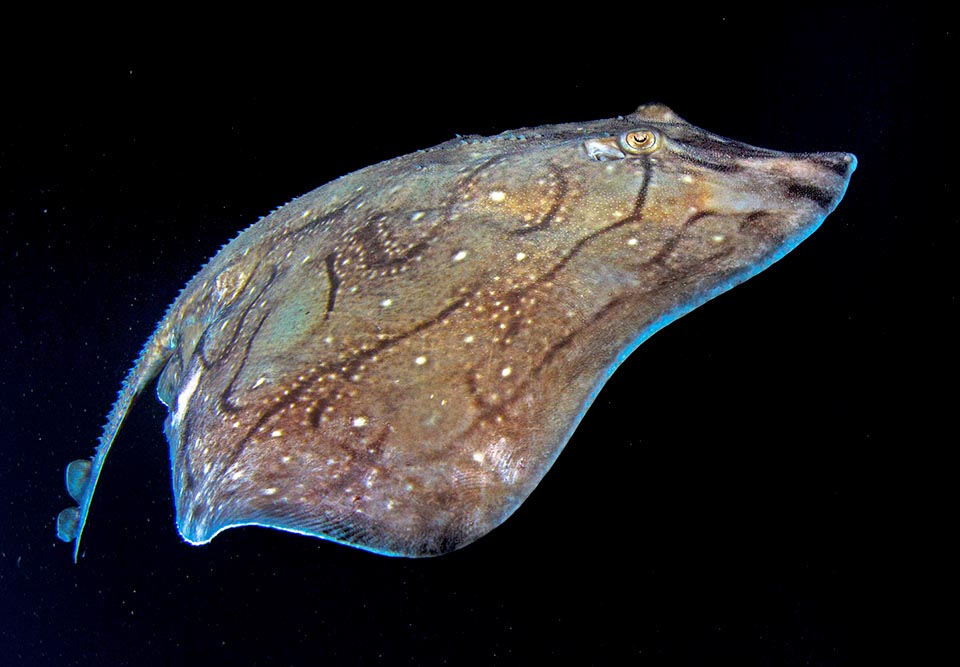
Raja undulata ray is an endangered species, present along the coasts of the Mediterranean and of eastern Atlantic, from South Ireland up to the Canaries and Senegal © Raimundo Fernández
Raja undulata Lacepède, 1802, known as Undulate ray and often confused with other species, belongs, like the sharks, to the class of the Chondrichthyes, that of the cartilaginous fishes, to the order of the Rajiformes, and to the family of the Rajidae, that includes more than 150 species of oviparous rays.
Like the catfish sharks, these abandon in fact their eggs on the bottom of the sea, protected by solid horny cases, whilst in the ovoviviparous rays, like, for instance, in the order of the Myliobatiformes the great Aetobatus ocellatus belonging to the family Aetobatidae or the multicoloured Taeniura lymma of analogous size, inserted in the Dasyatidae, the embryos grow inside the womb.
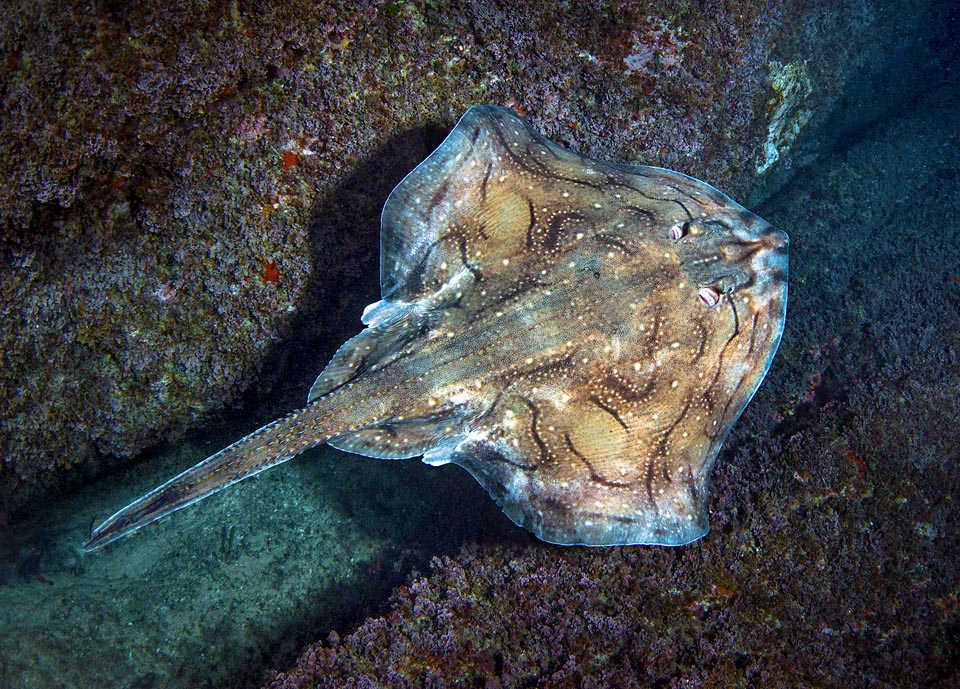
It’s about 60-80 cm long and even if presenting a high chromatic variability, may be easily recognized by the wavy black patterns on the back flanked by small white dots © Raimundo Fernández
Raja is the name Romans gave to the rays, whilst the specific term undulata, undulate, veined in Latin, refers to the characteristic sinuous pattern of the dark lines on the back of this fish, even if after some is a reference to the undulations of the huge pectoral fins while swimming.
Zoogeography
Raja undulata is present in eastern Atlantic, from southern Ireland and England to the Canary Islands and Senegal, including the Mediterranean, where it is more frequent on the western side though reaching the coasts of Greece, Israel and Lebanon.
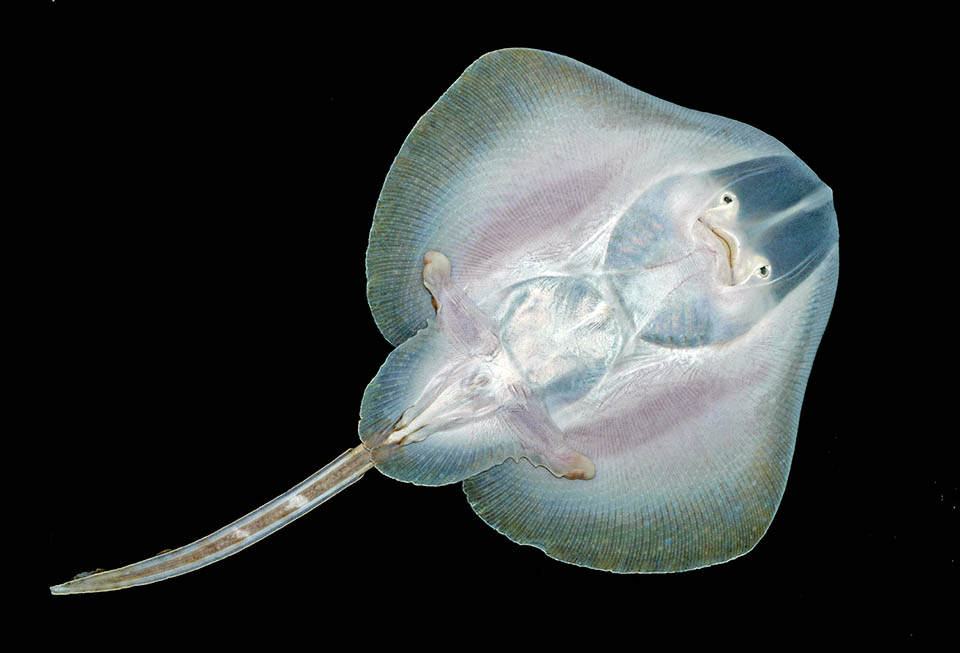
Male seen ventrally. We note the back of the eyes, the mouth followed by 5 rows of gills per side, and below, close to the pelvic fins, the two copulatory organs © G. Mazza
Ecology-Habitat
Raja undulata is a demersal nocturnal species that hides during the day hours under the sandy or gravelly bottoms, between 50 and about 200 m of depth, having only the eyes bulging for observing the surroundings in the case there were predators or passing-by preys.
Morphophysiology
The normal size of an Undulate ray is of about 60-80 cm with a weight of 4-5 kg, but a record exists of 100 cm and 10 kg.
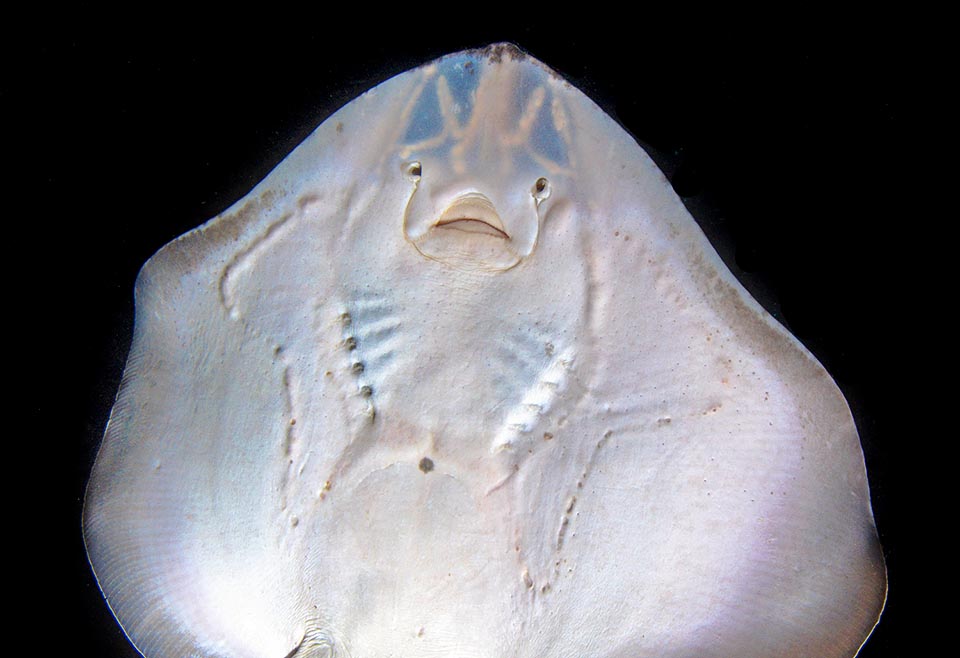
Here is well visible the outer run of the Lorenzini’s Ampullae starting parallel to the fins and reach the body bending after a wide central groove © Raimundo Fernández
The body, dorso-ventrally flattened, is sub-circular, definitely less rhomboidal than other rays, and also the rostrum, with a just hinted apex, presents roundish on the sides.
The dorsal side is wrinkled, covered as it is, with dermal denticles that get the shape of spines on the dorsal median line, proceeding then also on the robust caudal appendage almost as long as the disk.
On the background colour, usually brown, but also greenish or grey, stands out an unmistakable drawing formed by black wavy lines with small white dots on the border, to which add white spots and dark zones, especially on the head, that increase the camouflaging effect.
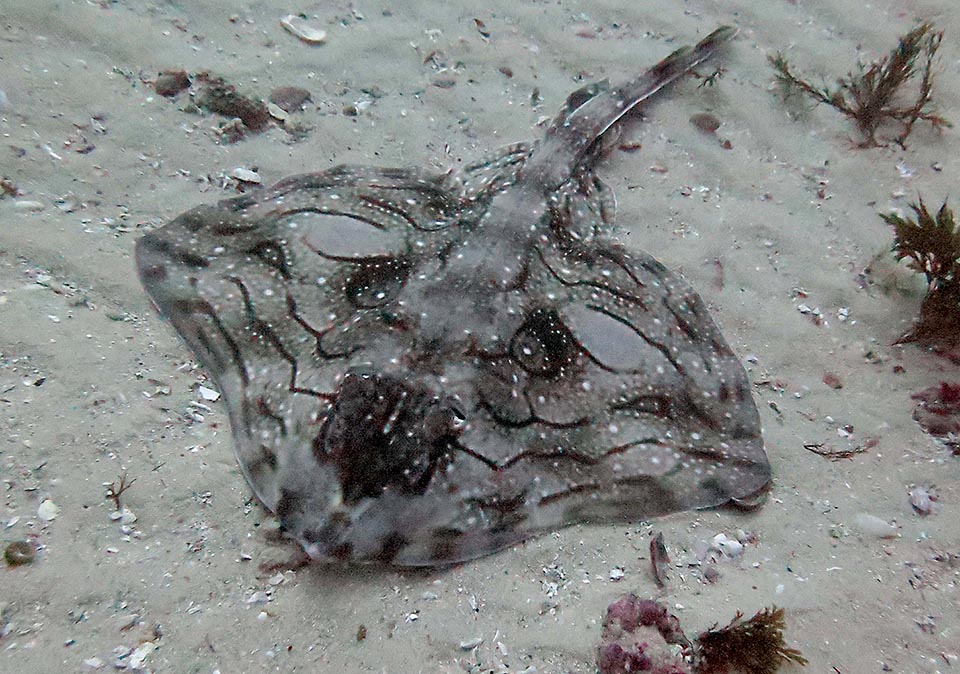
These allow to locate the electric field emitted by the possible preys hidden under the sand, usually crustaceans and mollusks © Marco Denicolai
The protruding eyes, without nictitating membrane, are flanked by a showy spiracle that pumps the oxygenated water towards the gills. This then gets put through the gill slits thus maintaining clean the respiratory organs also when the fish is resting sunken on muddy bottoms.
The ventral side, mainly smooth, is white, to get confused when seen from below with the sparkling of the sea when the fish is swimming.
Unlike the sharks, the pectoral fins do not start from the body but are fused to the head, and under these we note the exit pores of the Ampullae of Lorenzini. They are not many, but arranged on a wavy line, they are sufficient for locating the magnetic fields emitted by their small benthic preys.
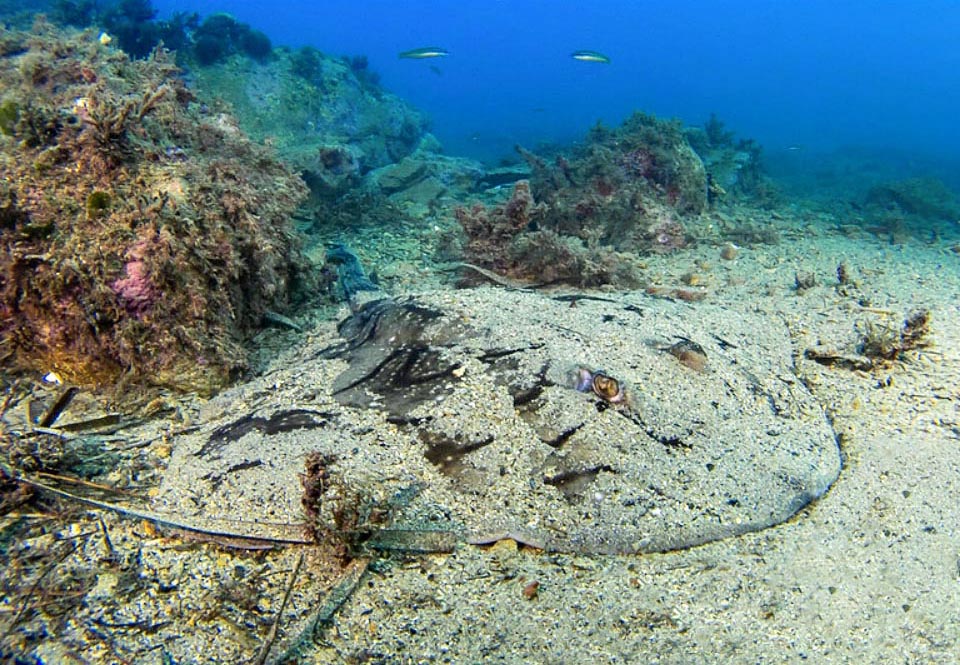
But sunken into the sand the Undulate ray hunts also in ambush the passing-by fishes, while resting during the day hours © Raimundo Fernández
In the males, the small ventral fins also here look at the base of the two copulatory pterygopodia for conveying the sperm.
There is no anal fin. The dorsal ones, of modest size, are located at the caudal extremity well apart and sometimes spaced out by two spines, but unlike many rays, like all Rajidae, the tail does not end with a poisonous spine.
On the ventral face, over the 5 gill slits per side, opens a slightly arcuate mouth covered by chisel or shield shaped teeth. In the males the upper jaw has 40-50 compact rows and the central teeth are longer and sharper, probably for catching the female while mating.
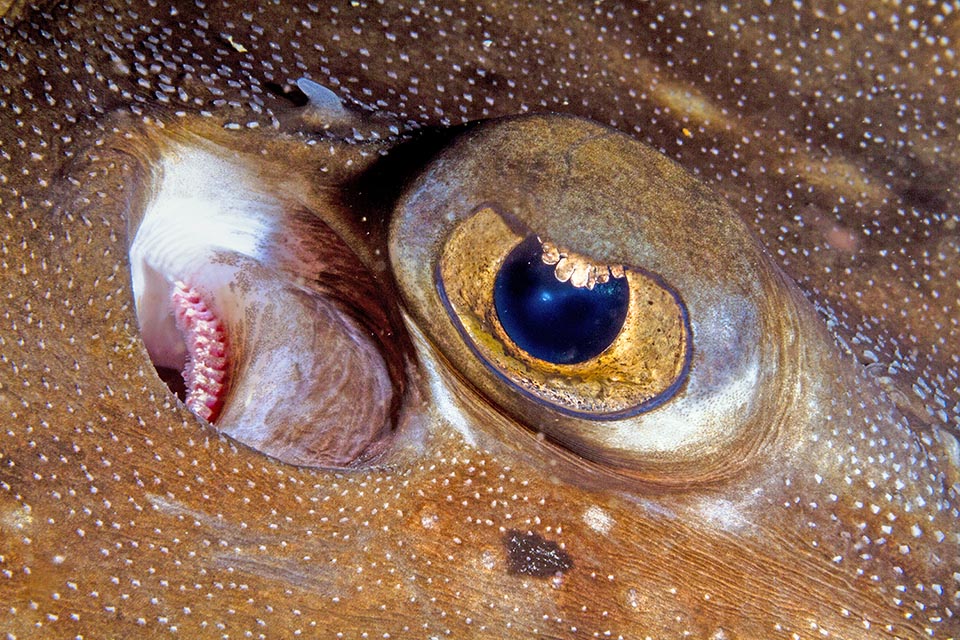
Close up view of the eye, always alert, without nictitating membrane and of the big spiracle, left, that pumps the oxygenated water to the gills. This then will get out through the gill slits, placed on the ventral side, thus keeping clean the breathing organs also when the fish is resting buried into muddy bottoms © Raimundo Fernández
Ethology-Reproductive Biology
Raja undulata feeds, by sounding the bottom, of crustaceans and mollusks, but also of small fishes it often hunts in ambush.
The fecundation, belly to belly, takes place in spring in the Mediterranean and during the summer months in the Channel Sea, where the temperatures are much lower.
Unlike the sharks or the Giant manta ray (Mobula birostris) that gets away with it in two minutes, the mating lasts long, with the male stuck for about one hour with one of its pyerygopodia to its partner’s cloaca.
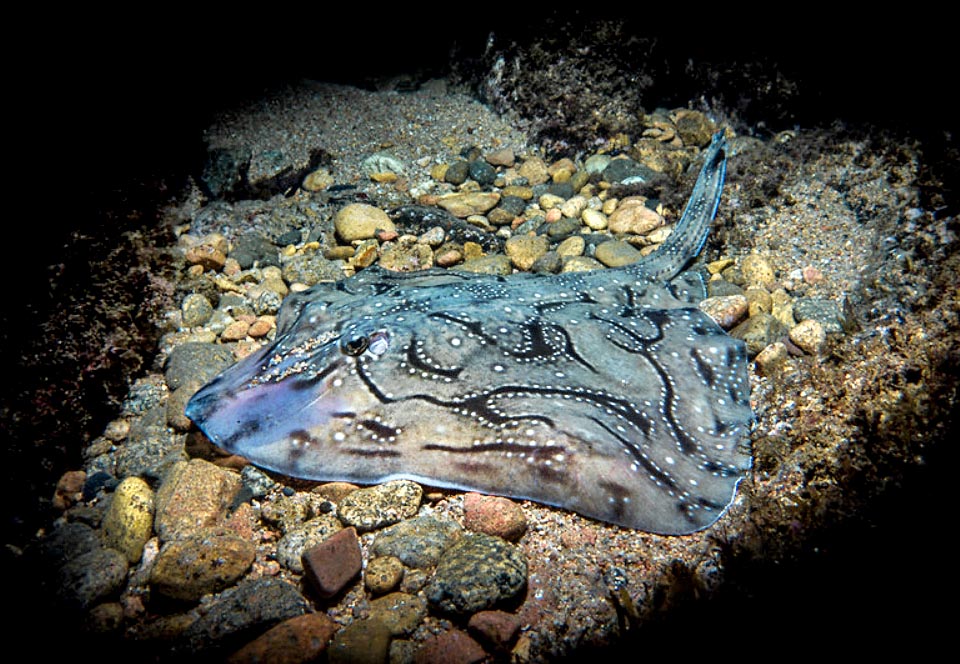
Elegant mimetic livery with more marked traits. Like in the first photo are visible the spines of the dorsal median line that continue on the robust caudal appendage © Raimundo Fernández
After about 25 days the females begin to deliver: usually 2 eggs at a time for several weeks, per a total of about 80 eggs.
They are protected by a dark brick horny case, 45-52 mm wide and 82-90 mm long not counting the appendages, at the two extremities, like horns. They are abandoned on the sandy bottoms and the pups, nourished by the vitelline reserves, are born after approximately three months, provided a sea storm does not throw their case on the beach.
In aquariums it has been observed that they get out from a transversal slit between the horns. They measure about 14 cm and have a life expectancy of 13 years, even if some scholars, based on the analyses of the vertebrae, think that the Undulate ray may reach 20-23 years.
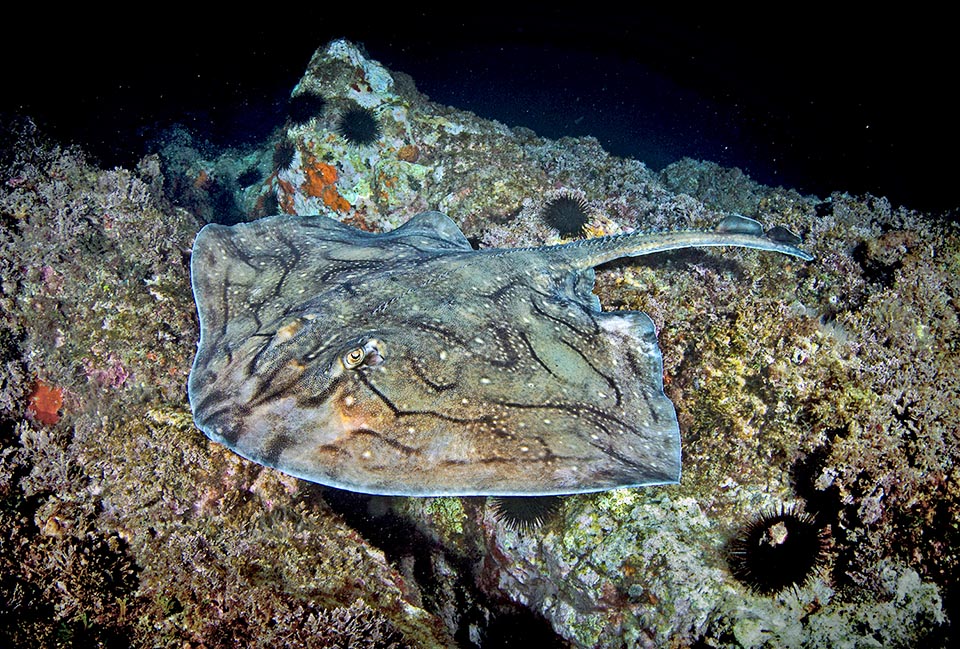
Mating may last even two hours. After about 25 days the females release on the bottoms up to 80 eggs, two at a time, for several weeks. Some of them are miserably thrown on beaches by heavy sea storms, but the species is mainly endangered by the very low resilience and slaughters done by the trawling nets © Raimundo Fernández
What is certain is that the growth is very slow and that the young are often fished before reaching the sexual maturity. The trawl nets make slaughters, so much that in 2022 the fishing vulnerability index already marked 66 on a scale of 100.
Also the resilience is low with a minimum time for the doubling of the populations of 4,5-14 years. Unfortunately, therefore, Raja undulata appears since 2023 as “NT, Near Threatened” in the IUCN Red List.
Synonyms
Raja picta Lacepède, 1802; Raja mosaica Lacepède, 1802; Raja fenestra Rafinesque, 1810.
→ For general information about FISH please click here.
→ For general information about CARTILAGINOUS FISH please click here.
→ For general information about BONY FISH please click here
→ To appreciate the BIODIVERSITY of CARTILAGINOUS FISH please click here.
→ To appreciate the BIODIVERSITY of BONY FISH please click here.
